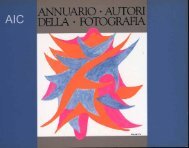ITALIANA - AIC Associazione Italiana Autori della Fotografia ...
ITALIANA - AIC Associazione Italiana Autori della Fotografia ...
ITALIANA - AIC Associazione Italiana Autori della Fotografia ...
You also want an ePaper? Increase the reach of your titles
YUMPU automatically turns print PDFs into web optimized ePapers that Google loves.
<strong>AIC</strong><br />
ROBERTO<br />
GIROMETTI Cinema-<br />
Cinema<br />
e cinema-tv<br />
Come tutti coloro che fanno il<br />
cinema anch'io, quando posso,<br />
mi reco a visitare mostre,<br />
presentazioni, incontri ed altre<br />
manifestazioni dove si parla<br />
d'Immagine.<br />
Naturalmente, da qualche tempo<br />
in qua, oltre che d'immagine<br />
cinematografica si tratta pure di<br />
immagine televisiva, ed è giusto.<br />
Ma ascoltando alcune persone si<br />
potrebbe pensare che tra<br />
Cinema e TV ci siano anni luce<br />
di distanza, mentre invece vi<br />
posso assicurare, ci sono<br />
soltanto una ventina d'anni, o<br />
poco più!<br />
I primi passi del cinema hanno<br />
inizio nel 1887, quando George<br />
Eastman brevettò la pellicola di<br />
celluloide, ed esattamente 8 anni<br />
dopo, il 28 dicembre 1895, Louis<br />
Lumière, col suo<br />
"cinematographe", presenta il<br />
primo spettacolo<br />
cinematografico al pubblico.<br />
Quando invece si viene a parlare<br />
di televisione, non è certa la data<br />
dei primi esperimenti, perché<br />
molti sono gli inventori che se<br />
ne attribuiscono la paternità.<br />
Primo tra tutti il russo Sergej<br />
Novorovsky, pioniere <strong>della</strong> TV<br />
sovietica, che ha affermato che<br />
già nel 1907, Boris Lbovic Rosing<br />
aveva sperimentato tale mezzo,<br />
quantunque non esistano notizie<br />
precise in proposito.<br />
Solo dal 1920 in poi si hanno<br />
Like most other people involved in filmmaking, when I have the time<br />
I visit exhibitions, attend film presentations, participate in<br />
meetings and other events of which the image is the main focal point.<br />
For some time now, this has obviously meant the television and<br />
cinematographic image, and it is right that this is so. Although listening<br />
to some people, you would think that Cinema and Television were light<br />
years apart. I can assure you, however, that this is not true, and at the<br />
most, there are only about twenty years between them!<br />
The Cinema had its beginning in 1887, when George Eastman patented<br />
celluloid film and, eight years later, Louis Lumière projected his first<br />
film for the public, using his "cinematographe". Asfar as Television is<br />
concerned, however, it is not easy to establish a date for the first<br />
experiments, as many engineers claim to have invented the medium.<br />
First and foremost, the Soviet Television engineer, Sergei Novorosky, who<br />
claimed that television experiments had already been conducted by<br />
Boris Lubovic Rosing in 1907, although these are not reported anywhere.<br />
It is only from 1920 onwards that more precise information is available,<br />
even though during this period many countries — the U.K., the U.SA.,<br />
Germany, Russia and Japan — were competing to be the first to transmit<br />
the image. Between them, they came up with more than fifty different<br />
systems for actually transmitting the image, while there was already<br />
considerable opposition regarding the two methods of constructing the<br />
image itself.<br />
Some engineers maintained that the television images should be created<br />
with an electronically scanned system using the cathode ray tube that<br />
had then recently been invented (Crookes); others were convinced it<br />
should be created mechanically. However, the technical limitations and<br />
the poor quality of the image produced by the latter system (John Logie<br />
informazioni più sicure,<br />
quantunque molti paesi<br />
gareggino tra loro per giungere<br />
alla trasmissione di immagini.<br />
Dalla Gran Bretagna agli USA,<br />
dalla Germania alla Russia, fino<br />
al Giappone, esistono più di<br />
cinquanta proposte per la<br />
trasmissione delle immagini a<br />
distanza, mentre già si profila<br />
una fondamentale opposizione<br />
tra i due sistemi costruttivi<br />
dell'immagine TV.<br />
Alcuni pionieri sostenevano che<br />
la televisione doveva scaturire in<br />
forma elettronica, basata sul<br />
tubo a raggi catodici di recente<br />
scoperta (Crookes); altri,<br />
convinti nelle possibilità di una<br />
TV a funzionamento meccanico.<br />
Ma limitazioni tecniche e la<br />
scarsa resa delle immagini<br />
giocarono un ruolo negativo per<br />
i sostenitori di tale teoria (John<br />
Baird). Quest'ultimo tuttavia<br />
potè per primo trasmettere<br />
un'immagine a distanza, anche<br />
se di qualità assai scadente, di 16<br />
righe.<br />
Un miglioramento ebbe luogo ad<br />
opera di C. Francis Jenkins,<br />
raggiungendo le 60 righe nel<br />
1932. Finalmente Vladimir<br />
Zworykin, qualche tempo dopo,<br />
costruì negli USA un<br />
iconoscopio che raggiungeva le<br />
240 righe per quadro.<br />
Gli esperimenti tuttavia<br />
continuavano anche negli altri<br />
Baird) were very much against it Nevertheless, Baird was the first to<br />
transmit an image composed of 16 lines, even though the quality was<br />
very poor.<br />
C. Francis Jenkins improved on this, by transmitting an image<br />
composed of 60 lines in 1932. And some time later, Vladimir Zworykin<br />
finally succeeded in transmitting an image of 240 lines, using an<br />
iconoscope he had built in the U.SA.<br />
Nevertheless, other countries continued to experiment: Kenjro<br />
Takayanagi proceeded with his research in Japan; as did the Russians<br />
who, thanks to Yakov Riftin, has already made great progress at the end<br />
of the 1920s.<br />
However, the first actual television broadcast was made by the B.B.C, on









